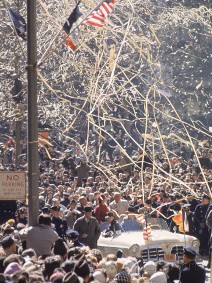space race
The Space Race
Vocabulary
| catch | compete | space (2) |
| react | explore | rendezvous |
| feat | drive (2) | accomplish |
| launch | respect | center-stage (2) |
| orbit | satellite | each other |
| fund | massive | follow-up |
| vow | respond | spacecraft |
| rival | capsule | carry/carried |
| probe | land (2) | propaganda |
| flight | last (2) | cosmonaut |
| sub- | man (2) | chimpanzee |
| leap | mission | astronaut |
| lunar | catch-up | steady/steadier |
| giant | engage | independent |
| pace | goal (2) | characterize |
| fade | intense | cooperation |
| pursue | artificial | inter-planet |
| detail | headway | attendance |
| melt |





The Space Race
From the late 1950’s to the early 1970’s, the Soviet Union and the United States engaged in a “Space Race”. The two countries competed with each other in space exploration, driving both to great feats of accomplishments.
During this time, however, politics and propaganda often took center-stage over science and technology.
Sputnik
The Space Age officially began on 4 October, 1957 when the Soviet Union successfully launched Sputnik I, the first artificial satellite to orbit the earth.
The world reacted with surprise, fear, and respect. Soviet Premier Nikita Khrushchev ordered massive funding for follow-up projects while American leaders vowed to catch up.
More Soviet successes followed. A month after Sputnik, another satellite, Sputnik 2, carried the first “cosmonaut”, a dog named Laika, into space.
Explorer
The United States responded in 1958 by launching the satellite Explorer 1, followed a few months later by Vanguard 1.
The following year, a Soviet probe, Luna 1, passed close to the moon, while Luna 2 became the first to land on it.
Yuri Gagarin
In 1961 Soviet cosmonaut Yuri Gagarin became the first man to orbit the earth in the spaceship Vostok I. The flight lasted 108 minutes and the ship returned safely.
Valentina Tereshkova became the first woman in space in Vostok IV in 1963.
The Chimpanzee
The US sent a chimpanzee named Ham on an 18-minute flight in a capsule in 1961, and its first manned space flight later that year with astronaut Alan B. Shepard, Jr. He flew a 15-minute suborbital mission. In 1962, John H. Glenn, Jr., became the first American to orbit the earth.
The first manned voyage to the moon began in 1968 when the US launched the Apollo 8 spacecraft. It orbited the moon 10 times and returned safely to the earth.
“That’s one small step for a man…”
Then finally on 20 July, 1969, U.S. astronauts Neil Armstrong and Buzz Aldrin landed their Apollo 11 lunar module on the moon. When Armstrong set foot on the moon, he said his famous, “That’s one small step for a man; one giant leap for mankind”.
End of the Space Race
U.S. astronauts made five more moon landings before the Apollo lunar program ended in 1972. The Space Race itself faded by the end of the 1970’s when the former rivals began to pursue independent goals.
Today, space programs are characterized by a steadier pace and more international cooperation.
The British Interplanetary Society
In the 1940’s, the British Interplanetary Society published detailed plans for manned lunar landing vehicles, space suits, and orbital rendezvous.
However, the British, who had been a very strong scientific and industrial power before World War II, made little headway.
All the best British scientists and engineers had gone to the United States. Those who remained had very little money and support to develop a British space program.
A Party in New York City
In 1969 New York City hosted a big party to celebrate the first landing on the moon. A British politician in attendance decided to make a speech.
He proclaimed, “The Russians were the first to go into space. The Americans were the first to land on the Moon. However the British . . . will be the first to go to the SUN! Yes, we are planning to land a man on the Sun!
A Trip to the Sun
There was silence in the audience. Then a Russian engineer asked, “What will you do about the intense heat and light? Have you developed new materials that won’t be burned or melted by the sun?” An American scientist added, “And what about the sun’s radiation? How will you protect the astronauts against it?”
The British politician laughed. “Ha ha. Do you think the British are stupid? We’ll go at night!”
Questions
1. What was the “Space Race”?
2. In the Space Race, the Soviet Union and United States were motivated by financial gain (profits). True or false?
3. Sputnik was . . . . . .
4. Was everyone surprised, awed, impressed, and fearful?
5. Who was Laika (and Strelka)?
6. The Soviet Union landed the first spacecraft on the moon. Is this right or wrong?
7. Who were Yuri Gagarin and Valentina Tereshkova?
8. Did the US send its first rocket directly to the moon; or did it work in stages?
9. Who was Neil Armstrong? What did he say?
10. What are today’s space programs like?
A. Have there been astronauts or cosmonauts from your country?
B. The landing on the moon was the greatest single achievement of mankind. Do you agree?
C. Was it worth the billions of dollars in investment?
D. Do you think governments should continue investing in space programs?
E. I would like to be an astronaut or cosmonaut. True or false? Would you like to be a space tourist?
F. What do you think will happen in the future?
